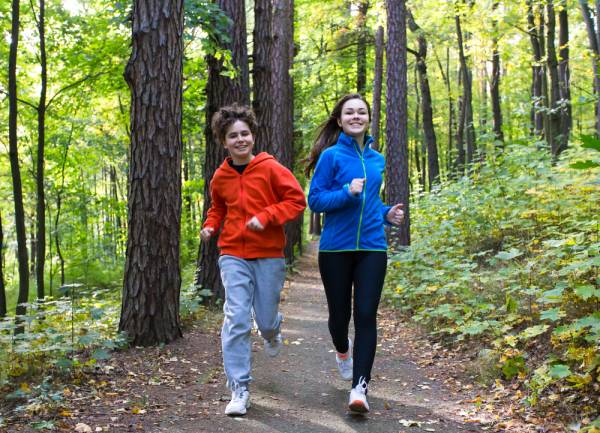A school is supposed to nourish a student in every way: intellectually, socially, morally, and, of course, physically. But all signs in this modern society point to how caretakers in the education field are failing.
The State of Modern Schools
My typical high-school day is seven hours long, so that means seven hours each day on my bum. It’s no wonder kids get lethargic or jittery as the day drags on, especially given early school starts. It’s also no wonder most young people have low muscle mass, below-par balance and coordination, and other issues that come with being sedentary.
“America’s current generation of young people may be the first to live shorter lives than their parents.”
Schools as far apart as New York and Australia have banned cartwheels in the name of “safety.” School lunches in America are known for their dismal resemblance to fast-food meals, and when Michelle Obama tried to convince gridlocked lawmakers to pass healthier nutrition standards, students turned around and ridiculed her, pining for their Friday pizzas and French fry snack stands.
READ MORE: 4 Ways You Can Fight Back Against the War on Physical Education
What the Future Holds for Our Kids
What saddens me is that the issue of health and fitness in kids is trivial in most people’s eyes. Most people know of the morbidly growing rate of childhood obesity and the dire predictions that America’s current generation of young people may be the first to live shorter lives than their parents.
All children should experience wellness-centered lifestyles and teachings as early as possible – and school is the perfect setting for that. If administrators and legislators continue to pile on stressful academic tests while ignoring health, they’re just sowing unhealthy futures for all of us.
GET INVOLVED: Fight for the Right to Recess – 3 Reasons Kids Need Break Time

A Failed Attempt at Improvement
This is important and sensitive, especially to me as a high-schooler, because school eats up huge portions of a child’s formative years. Five days a week, virtually year-round, for the first eighteen years (or more) of life, the student is forced to sit down for long, practically uninterrupted hours. There are many ways to tackle this sedentary institution, but some are more effective than others.
Exhibit A is the quick fix: a simple replacement of inactivity with the chance to move more. That’s what one North Carolina school has implemented with their Read and Ride program, giving students a chance to pedal on exercise bikes while they flip through books.
“Schools as far apart as New York and Australia have banned cartwheels in the name of ‘safety.'”
This approach reflects some concern over physical activity throughout the day, but how is it any better than climbing on a treadmill at the globo gym with the latest tabloid in hand and strolling along slowly for 45 minutes? This is very much the lazy man’s approach, trying to meld together work and movement to the detriment of both.
Also, this approach does nothing to encourage healthy habits outside of school. There is no education here on how to care for the body, just another task mandated by the unseen powers that be.
RELATED: Better Cardio Linked to Better Reading Score for Kids
When CrossFit Gets in the Picture
A better remedy would be to reform physical education classes. I feel that “gym class” is a joke, but on the rare occasions the teachers decide to up the ante a bit – with a Beep Test, for instance – my peers freak out. Maybe this is because most days consist of the teachers temporizing the start of the exercise by giving us too much time to “change”, then lazily guiding us through static stretches. It shouldn’t be this way.
RELATED: 3 Reasons Your Kids Should Try CrossFit
Thus, it’s gratifying to learn about more progressive schools going the extra mile by incorporating CrossFit workouts and instruction, as in the case of Rancho High School in Nevada. Because the change is more vigorous and thorough, the results are inspiring. Kids are taking their grades more seriously and even their parents have been motivated to tag along and lose weight. There is even a waiting list for entry into the CrossFit classes, which exemplifies the desire people have to turn their lives around when given the opportunity.
“[I]t’s gratifying to learn about more progressive schools going the extra mile by incorporating CrossFit workouts and instruction.”
A Change of Olympic Proportions
While not all schools are blessed to have this kind of opportunity, the Claremont schools in California took advantage of the Olympic champion who happened to be in the area. Partnering with Oakmont Outdoor School to reach out to grade-schoolers in the district, 2008 Olympic decathlon gold-medalist Bryan Clay launched Project Champion to inspire kids to get moving.

The incentives are superb, with the opportunity to meet the star athlete himself and get his autograph, but the essence is also in the right place. Each month, administrators introduced character traits and highlighted how planning to log miles demonstrated those virtues and would help students eventually attain the prize of their choice. The program demonstrates an intertwining of academic excellence with a foundation for lifelong health.
DOES YOUR CHILD HATE SPORTS? READ: 6 Sports for Kids Who Aren’t “Sporty”
Health and Fitness Is Our Birthright
I’m moved by a particular chapter that Mark Sisson includes in his book The Primal Blueprint. He juxtaposes a Primal family – Grok, with his wife and kids – against modern day Ken and Kelly Korg (Grok spelled backwards, a metaphor for the state of modern society). Even the kids in the Grok family are inured to physical hardship and highly proficient in movement, perhaps at the level of serious (adult) CrossFitters and other physical culturists in this day and age.
“I’m not advocating for high-level gymnastics classes in schools but for more awareness of and respect for our physical gifts.”
For example, Sisson describes a close encounter caveman Grok and his son have with a bear after an exhausting hunt. Because of his fitness and movement skill, the young boy can sprint away with his father while navigating natural obstacles like fallen logs and rivers. He has mental toughness, along with gymnastics skills and the ability to move his body efficiently.
Kids are capable of such movement mastery and health. It should be their birthright. I’m not advocating for high-level gymnastics classes in schools (yet) but for more awareness of and respect for our physical gifts. Change starts at the roots. And if you’re going to keep gym class in school, you might as well step up your game.
References:
1. TeachTought, LLC. “What I Learned By Doing What I Ask Students To Do.” Accessed November 4, 2014.
2. Fast Company. “This School Has Bikes Instead Of Desks — And It Turns Out That’s A Better Way To Learn.” Accessed November 4, 2014.
3. Education Action Group Foundation. “School bans ‘unsupervised cartwheels’ on playground.” Accessed November 4, 2014.
4. Ryot Corporation. “New York School Bans Balls, Tag, Cartwheels and Childhood In General.” Accessed November 4, 2014.
5. CrossFit, Inc. “Class-Action CrossFit.” Accessed November 4, 2014.
6. Claremont Courier. “‘Project Champion’ has students running for gold.” Accessed November 4, 2014.
Photos courtesy of Shutterstock.






